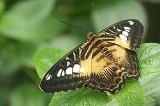
Lepidoptera
Overview
Lepidoptera is a large order
of insect
s that includes moth
s and butterflies
(called lepidopterans). It is one of the most widespread and widely recognizable insect orders in the world, encompassing moths and the three superfamilies of butterflies
, skipper butterflies
, and moth-butterflies
. The term was coined by Linnaeus in 1735 and is derived from Ancient Greek
(scale) and (wing). Comprising an estimated 174,250 species, in 126 families
and 46 superfamilies
, the Lepidoptera show many variations of the basic body structure that have evolved to gain advantages in lifestyle and distribution.
Order (biology)
In scientific classification used in biology, the order is# a taxonomic rank used in the classification of organisms. Other well-known ranks are life, domain, kingdom, phylum, class, family, genus, and species, with order fitting in between class and family...
of insect
Insect
Insects are a class of living creatures within the arthropods that have a chitinous exoskeleton, a three-part body , three pairs of jointed legs, compound eyes, and two antennae...
s that includes moth
Moth
A moth is an insect closely related to the butterfly, both being of the order Lepidoptera. Moths form the majority of this order; there are thought to be 150,000 to 250,000 different species of moth , with thousands of species yet to be described...
s and butterflies
Butterfly
A butterfly is a mainly day-flying insect of the order Lepidoptera, which includes the butterflies and moths. Like other holometabolous insects, the butterfly's life cycle consists of four parts: egg, larva, pupa and adult. Most species are diurnal. Butterflies have large, often brightly coloured...
(called lepidopterans). It is one of the most widespread and widely recognizable insect orders in the world, encompassing moths and the three superfamilies of butterflies
Butterfly
A butterfly is a mainly day-flying insect of the order Lepidoptera, which includes the butterflies and moths. Like other holometabolous insects, the butterfly's life cycle consists of four parts: egg, larva, pupa and adult. Most species are diurnal. Butterflies have large, often brightly coloured...
, skipper butterflies
Skipper (butterfly)
A skipper or skipper butterfly is a butterfly of the family Hesperiidae. They are named after their quick, darting flight habits. There are more than 3500 recognized species of skippers and they occur worldwide, but with the greatest diversity in the Neotropical regions of Central and South...
, and moth-butterflies
Hedylidae
Hedylidae, the "American moth-butterflies", is a family of insects in the lepidopteran order, representing the superfamily Hedyloidea. They are an extant sister group of the butterfly superfamilies Papilionoidea and Hesperioidea...
. The term was coined by Linnaeus in 1735 and is derived from Ancient Greek
Ancient Greek
Ancient Greek is the stage of the Greek language in the periods spanning the times c. 9th–6th centuries BC, , c. 5th–4th centuries BC , and the c. 3rd century BC – 6th century AD of ancient Greece and the ancient world; being predated in the 2nd millennium BC by Mycenaean Greek...
(scale) and (wing). Comprising an estimated 174,250 species, in 126 families
Family (biology)
In biological classification, family is* a taxonomic rank. Other well-known ranks are life, domain, kingdom, phylum, class, order, genus, and species, with family fitting between order and genus. As for the other well-known ranks, there is the option of an immediately lower rank, indicated by the...
and 46 superfamilies
Taxonomic rank
In biological classification, rank is the level in a taxonomic hierarchy. Examples of taxonomic ranks are species, genus, family, and class. Each rank subsumes under it a number of less general categories...
, the Lepidoptera show many variations of the basic body structure that have evolved to gain advantages in lifestyle and distribution.

